How to Merge Two User Accounts Windows 10

Computer manufacturers usually ship out their newly built PCs with partitioned internal drives. For example, they separate the drive for the Windows operating system and make another one empty and ideally used for storing new data for the user. While this is recommended, you can opt to merge such partitions to create a single unit that stores all the files. This can be used to free up space that a recovery partition takes up or remove these recovery partitions. This can also help clear up unnecessary partitions you may have set up along the way.

WHY THE NEED OF MERGING PARTITIONS IN WINDOWS 10?
Merging partitions happen by combining two different partitions into a single. It also means that a partition with unallocated space on the hard drive can be used to increase another partition's capacity. There are many ways that this can benefit you, and here are some of the scenarios.
- When making partitions, the goal is to allocate a certain amount of memory to each Partition, such that files are neatly organized and Volume is evenly distributed. Files such as documents, media, and operating system files can be separated so that one Partition goes to important system files, while the other can take up media and documents.
- Over time, system files might use up all the space allocated to them, particularly since new application data are typically saved in that Partition. This causes an imbalance in the allocation. By merging partitions, you can add some memory from a partition with more free space to the one with lesser space left.
- Having many partitions may confuse you in the long run. If you haphazardly save files into any partition without organizing them first, you might forget where you store them. Having fewer partitions help solve this problem.
- Recovery partitions normally get allocated with ample space for backups. However, they could create multiple copies and even multiple partitions that get stored all together and causes space to run out. By merging partitions, you will keep just the important recovery partition and get rid of the oldest ones, and free up space to allocate for the other important partitions in your computer.
Extra Tips: How to Utilize Disk Space Better
To use your disk space fully and competently, consider the tips below:
- Know how to resize your Partition
- Clean up junk files and unnecessary data on your drive
- Defragment readers frequently
However, if you are looking for ways to merge partitions, you have come to the right place. In this guide, we will show you step by step how to merge partitions in Windows 10.
HOW TO MERGE THE PARTITIONS USING WINDOWS DISK MANAGEMENT
Windows 10's very own Disk Management is capable of merging partitions. However, this does not allow files to be combined directly into the chosen Partition to be used, so you have to delete the Partition you least prefer before it goes ahead to transfer the allocated space to the selected Partition.
Step 1. Press Win + R to launch run. On the dialogue box that appears, key in diskmgmt.msc to launch Disk Management.
Step 2. Locate both partitions you prefer to merge and proceed by deleting one Partition first. For example, if you want to merge drives D: and C:, you first have to delete the D: drive (the one without important system files). To do this, right-click on the D: drive and then select the Data Volume option.
This will delete all the data stored within the drive. If you have important files on it, perform a backup before proceeding.
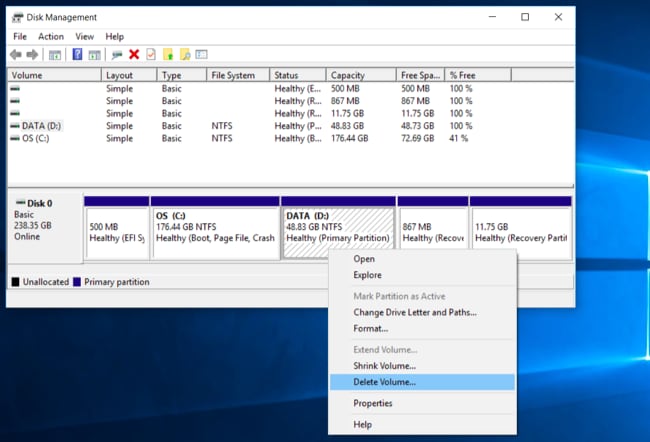
Step 3. Right-click on C: system partition and choose to Extend Volume on the dropdown options.
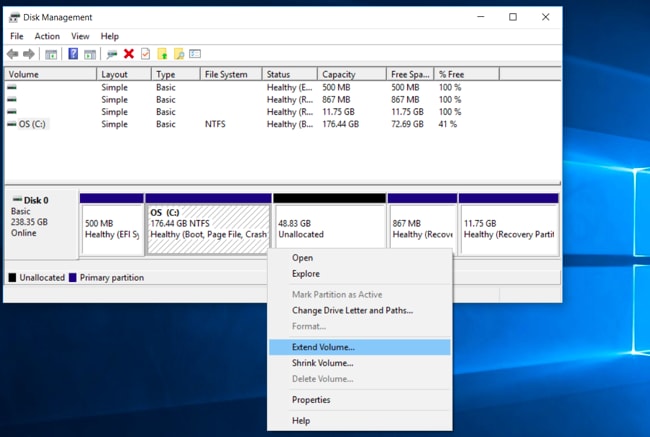
Step 4. Follow the Extend Volume Wizard instructions and select default options to merge the two partitions for Windows 10 successfully.
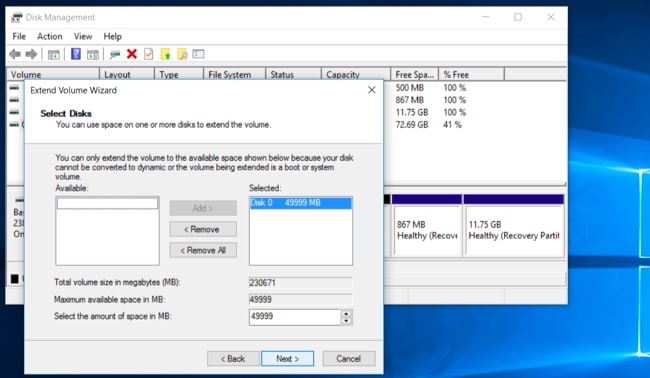
Step 5. Once the wizard finishes, you should be able to see the merged Partition with a larger disk space, which you can now use to store data.
Facts About Using Disk Management.
- The Disk Management utility is a built-in module of all Windows OS.
- Perform some tasks like CREATE / DELETE / FORMAT volume.
- Do not touch the default partitions of your PC as there is a risk of deletion.
- To reduce the size of a partition, use Shrink Volume function.
- To increase the size of a partition, use Extend Volume function.
- No volume merge functionality is available in Disk Management.
- Do not try to make changes unless you are not sure.
HOW TO MERGE THE PARTITIONS USING DISKPART COMMAND
The second method to merge the partitions in Windows 10 is using DiskPart, here is step-by-step guide you can follow:
Step 1. Type diskpart.exe and press Enter. You will see cmdprompt window.

Step 2. In the cmd prompt window, Input list volume and Enter. You will see list of all partitions.
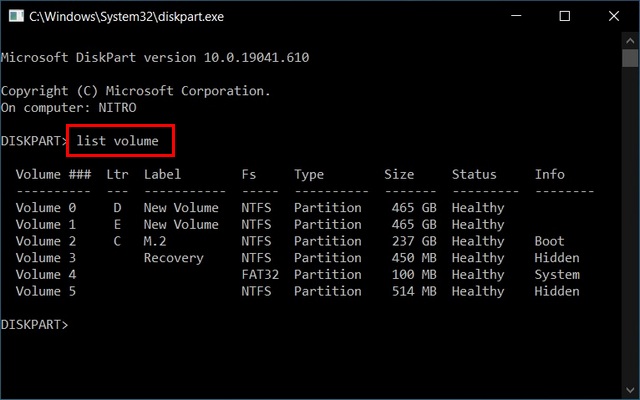
Step 3. Type select volume e and press Enter. (e is the right Partition driver you want to combine).
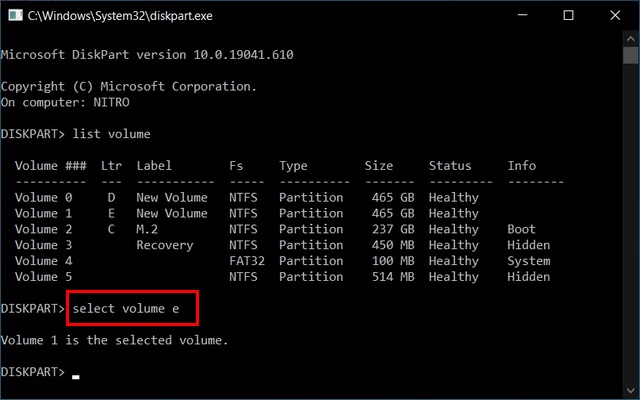
Step 4. Type delete volumeand press Enterto make that Volume ready for combination.
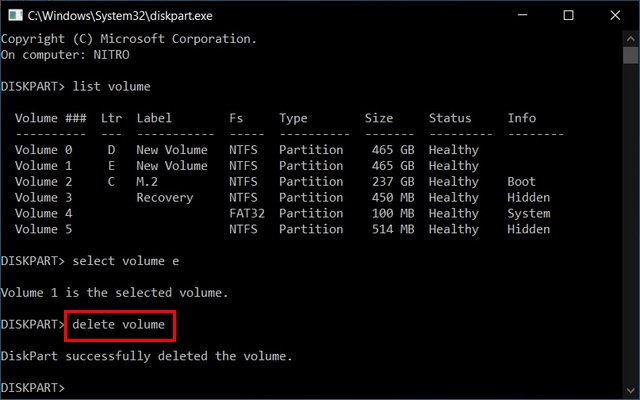
Step 5. Type select volume d and press Enter. (d is the left Partition driver you want to combine).

Step 6. Type extend and press Enter to extend this Partition. Now you will receive a message 'DiskPart successfully extended the volume.'
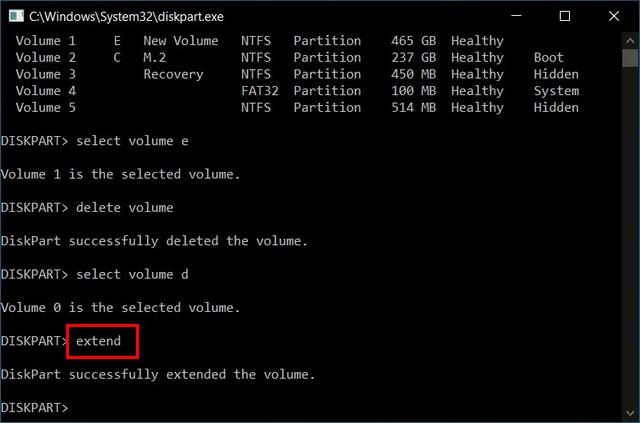
OTHER SAFE SOLUTIONS TO MERGE PARTITIONS FOR WINDOWS 10
Aside from using Disk Management and Diskpart command in Windows 10, there is other alternative software that you can use to merge partitions. This is done by downloading and installing the following applications and following their wizard to perform the merging of partitions:
Solution 1. KDE PARTITION MANAGER
The KDE Partition Manager is one utility application capable of managing disk partitions, devices, and file systems found on your PC. It can perform various functions for partitions, such as backing up and restoring files and creating, moving, deleting, copying, and resizing the partitions.
Solution 2. DISKGENIUS
DiskGenius is a complete utility program with a partition manager feature comprehensively designed to optimize disk use in Windows. It can resize, split, create, deleting, extend, format, hide, erase, and copy partitions to expand disk space.
Solution 3. PARAGON PARTITION MANAGER
Paragon Partition Manager is a free and Windows 10-supported application that organizes the hard drive and reallocates free space to improve the PC's performance. It has a user-friendly interface with a wizard that simplifies the work for you. It can perform various partition tasks using its intuitive technology.
Solution 4. PARTITION LOGIC
Another free software for partition merging is the Partition Logic, capable of copying entire disks from one to the other and performs various hard disk partitioning and disk management tasks.
Solution 5. AOMEI PARTITION ASSISTANT
The AOMEI Partition Assistant is a free partition management software deemed safe for personal and commercial usage. It is packed with all the necessary features for partitioning hard drives and as well as merging partitions. It also performs safety checks while performing such tasks, making partition management safe and efficient.
Want more options? Don't worry, we have a free partition management application to merge partitions on Windows 10, i.e., WondershareRecoverit Software. Download it and launch the installer file to gain access to the application features.
Things to Remember Before You Merge Partitions in Windows
- Back up data before deleting a partition because it will delete all data stored on the Partition at the same time when you delete a partition.
- You can delete one or more partitions to create enough unallocated space.
- You must delete the Partition contiguous to drive
- Windows 10 does not allow users to delete the system partition.
CONCLUSION
Data loss is a big concern when merging partitions, but you can avoid it if you back up your data before performing the function. Also, only perform merge partition if you are sure that it is necessary and would help improve your PC's performance. You can refer to an expert if you are not confident about performing such a task to ensure that your computer and data are safe even after the merge is done.
FAQ's
Can you combine partitions without losing data?
Yes. You can combine partitions without losing data only with a professional partition management application.
What is the process to Merge Partition?
There are three ways to merge partitions on windows 10.
- Disk Management Utility - only the drivers that are left to the driver can merge
- DiskPart - Merge two partitions
- 3rd party software - Merge with any driver.
Does deleting a partition erase data?
Yes. Deleting a partition will permanently erase data that is presently stored on it.
How to Merge Two User Accounts Windows 10
Source: https://recoverit.wondershare.com/partition-tips/merge-partitions-in-windows-10.html